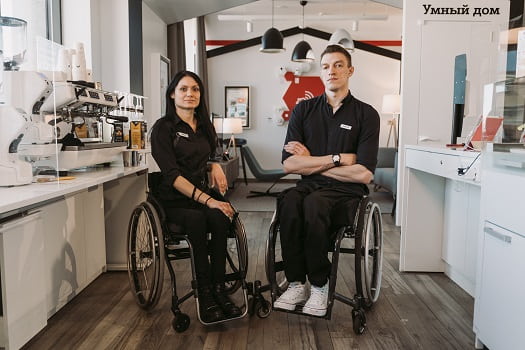Developing Accessibility in the Workplace | 10 Ways
Accessibility is making sure everyone whether disabled, or able has easy access around the workplace as well as its facilities. Although the concept of accessibility at work goes far beyond physical access and involves so much more.
Offering jobs for people with disabilities can be tricky and tedious on the part of the employer as well as the employee, especially when the accessibility at work isn’t properly managed.
Fact: it is advantageous for a business to portray a sense of equity, tolerance, and management of disability in the workplace, especially for their public image.
A recent study showed that in 2018, in partnership with the AAPD (American Association of People with Disabilities) and Disability:IN, Accenture reported about companies who embraced practices that support and encourage disabled individuals in the workplace do far better than their peers, having about 28 percent increased revenue with a bigger economic profit margin and twice the net income.
Carrefour, an international retail group that specializes in large-scale distributions with over 15,000 thousand stores worldwide, and also holds the spot of the largest retailing company in Europe has several awards for the initiative in incorporating disabled workers in Careffour’s system.
Developing an accessible workplace is important as well as beneficial to your business because of the opportunity it brings in terms of access to talent, more workforce as well as employee retention. All due to the message of disability inclusion in the workplace passed across by the company. In fact, there are many benefits to hiring people with disabilities.
Is your company offering inclusive jobs for people with disabilities? As an employer, you can publish your job offers on MyDisabilityJobs and reach thousands of qualified candidates.
An Accessible Workplace: One Thing or More?
Now when we talk about accessibility in the workplace, as much as we’re talking about convenience, structure, technology, and all that stuff we’re also talking about character, communication, accommodation, and sustenance of access in the workplace.
For you as an employer or human resource manager to get the best, especially out of the disabled’s access in the workplace, you need to be versatile in your approach.
Understanding the dimensions of accessibility in the workplace will better help you make the necessary adjustments or take a better attitude in handling your disabled employee and we’re going to take a quick run through them.
These dimensions are in three parts namely:
- Physical Accessibility
- Technological Accessibility
- Attitudinal awareness
Physical Accessibility
The Physical Accessibility of the workplace involves the physical and personal convenience of the staff, both able-bodied and disabled.

Though the advantages of accessibility extend beyond compliance, employers have to be acquainted with the requirements of the law under the Americans with Disabilities Act (ADA).
Access that must be provided includes:
- braille signage,
- wheelchair ramps,
- necessary work equipment,
- special parking space for disabled workers,
- and so on.
In some cases, offering part-time jobs for disabled people could also be a way to prevent your employees to be physically or mentally overwhelmed.
ADA compliance in the workplace must be encouraged and carried out.
Technological Accessibility
Technological Accessibility on the other hand emphasizes more on digital accessibility in the workplace. Technology has become the bedrock of modern industry.
It is important in almost every sphere of life and therefore it has to be accessible especially in a situation of disabled employees.
Lack of accessible technological facilities and tools in the workplace can hinder disables from performing their function in the workplace leading to a decrease in productivity.
Accessibility needed in this area includes AT-compatible devices, electronic correspondence, desktops, and portable computers, etc.
Attitudinal Awareness
Attitudinal Awareness is the most delicate of all three. The kind of mindset a person has affects the behavioral pattern of that person towards other people and concepts.

Wrong and discriminatory notions can negatively affect the working environment leading to the opposite of productivity.
This is not just on the part of employers but colleagues of these disabled workers as well.
- A disabled person should be respected and allowed to thrive not on the platter of his/her disability but because of his/her value and contribution to the job.
- Discrimination, gossips, backlash, pity, fear, downgrading, should not be part of the character of good employers as well as colleagues of the disabled person involved.
- When people with disabilities notice behaviors like this they may freak out and eventually quit and lose their confidence. Instead tolerance and accommodation, as well as friendship should be promoted to grow and thrive in the workplace.
Another way of bridging the gap between you as an employer and these people is by communication.
Discussing disability with the aim of better management as well organizing training to increase the perspective and awareness of your staff.
Increasing Accessibility in the Workplace in 10 Ways

Increasing the accessibility of the workplace is something that needs to be done if a properly functioning environment is to be achieved.
We’ve covered on the surface, the dimensions of accessibility just to clear the idea that all it involves is physical space and wheelchair access.
Increasing the accessibility in your workplace is necessary for dealing with disability issues in the workplace, whether you’re experiencing one currently or trying to be proactive.
Here are 10 ways that have been studied to help with accessibility at work, please note that they all fall into the dimensions mentioned above as applicable.
- Ensure to keep yourself updated on legislation regarding workplace accessibility.
- Get professional help on how best to improve the accessibility of your work environment. Some firms specialize in this, even down to office structure adaptability.
- Pay attention to digital improvement. Large keyboards, voice recordings, screen enlargement apps, and other assistive technologies will go a long way in getting the job done by your disabled employees.
- Accommodate disabled employees’ means of assistance, especially If it poses no threat to the general workplace.
A visually impaired person may have a guide dog for instance, if the animal poses no health or injury threats then, by all means, accommodate the animal in the environment.
- Work towards training your employees on proper work behavior and how things are done there. Organize programs to teach them the necessary etiquette, have meetings geared towards the communication of ideas and thoughts among employees.
- Company policies should be reviewed, especially to make certain that the employee is not working under unfavorable conditions helplessly.
- Prepare your mind for disability inclusion in the workplace. Don’t just think you can do it because it sounds nice and fair. Take your time to reason it out and understand the extent to which you can go at your level.
- Take your applicant accessibility to the next level. Pass your message of value and accommodation by providing accessible tech on your hiring site.
- Take note of your immediate need and start from there. Don’t spread yourself too thin.
- All disabilities are not visible, some are physical but hidden such as hearing loss, some are neurological such as epilepsy. Some are even mental such as ADHD, PTSD, and so on. Knowledge of this helps you better understand what you’re dealing with and how to handle it in your work environment.
Is your company offering inclusive jobs for people with disabilities? As an employer, you can publish your job offers on MyDisabilityJobs and reach thousands of qualified candidates.
Conclusion
Whether you’re creating or improving accessibility in your workplace, you must understand what you need and how to go about it.
Adapting to having disabled workers may seem a bit challenging for you as an employer or manager, but it’s a great step in embracing Inclusivity and taking your business up the productivity ladder. People are emotional and empathy is a great way to open the door of productive communication amongst each other.
Just make sure you have a good and understanding team and you will be able to carry out the effective accessibility change your workplace needs.
FAQ
The convenient availability of work tools, facility structures, and a well-organized working environment is what is generally referred to as access in the workplace.
You can increase your workplace accessibility by consulting experts on the structural adaptations you need, to suit the working experience expected of the employees as well as better management of disabled workers at your place of work.
Related articles:
Diversity Recruiting Strategies and How to Recruit Diverse Candidates
Disability in the Workplace: Developing Accessibility in 10 Ways
Challenges of Diversity in the Workplace & How to Overcome Them
Diversity Management: What is it and Concept
Diversity and Inclusion Topics for Discussion: 9 Talking Points
Managing Diversity in the Workplace: 10 Strategies
Inclusive Behaviors in The Workplace | 15 Ways to Promote it
Fostering Inclusion : Work Environment | 12 Ways to do it


leave your comment